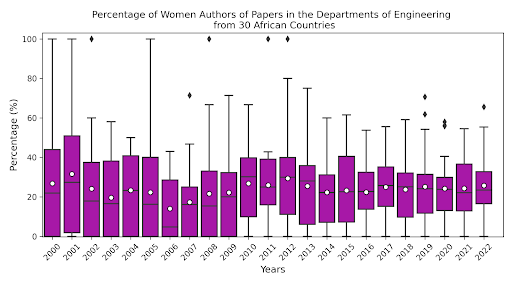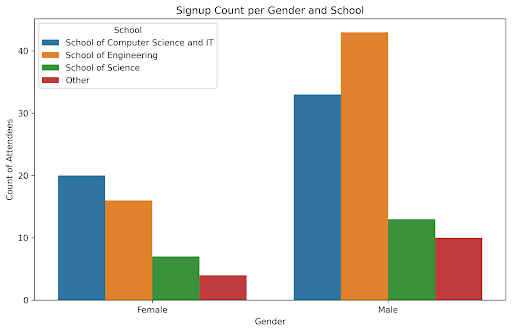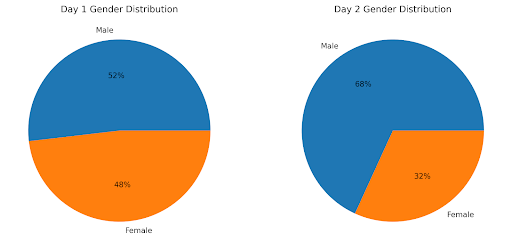Background
Girls and women have consistently been underrepresented in most Science, Technology, Engineering, and
Mathematics (STEM) professions, necessitating research. There is a need to define and execute measures
and policies to help reduce this gap. This project aims to analyse the representation of women in STEM
in Africa. The approach being used is analysing genders of authors of STEM papers from African universities
and analysing genders of members of staff from STEM faculties in African universities. From this analysis,
we will be able to determine the current representation of women in STEM and Africa. This will guide us in
the next step of formulating policies and curricula to help encourage women to join STEM fields in Africa.
Accomplishments
Preliminary studies have been conducted to analyse genders of STEM paper authors from 30 African universities
and genders of members of staff from STEM faculties from 5 African universities. The study was conducted to
test the applicability of this approach and to develop a methodology of achieving the analysis.
The following subsections outline what was done in the two studies.
Preliminary studies
Analysis of the gender of paper authors
In this task, the gender distribution of authors of papers in the fields of Engineering and Computer Science
from African universities was analysed. It was assumed that the gender distribution of authors of scientific
papers closely depicts gender distribution in STEM. A pipeline to classify the gender of paper authors was developed.
Data on scientific paper publication from the thirty African universities was obtained from Scopus.
For each university, a CSV file containing paper authors from all disciplines was obtained.
All papers from the Engineering and Computer Science departments of the institutions were also
downloaded as CSV files. Each of these CSV files contained details about papers of one of the two
disciplines chosen for analysis. Some of the details that were important for this analysis were the
paper's authors and year of publication. A pipeline was developed to classify the gender of paper authors.
Genderize API was used to classify the gender of paper authors from their names.
Figure 1 shows the flowchart of the gender classification pipeline.
The following results were obtained from the analysis done on the data of the 30 universities. Figures 2 and 3 show the percentage of female authors from the 30 African universities from 2000 to 2022.



Analysis of gender of members of staff
To be able to carry out more research and gender analysis participation in STEM,
we held the DSAIL Tech4Wildlife workshop, a 2 day program that attracted over 50
participants. It was aimed at educating the attendees on the practical application
of artificial intelligence in wildlife conservation efforts. Primarily undergraduate
and a few postgraduate students from Dedan Kimathi University of Technology and a
student from Egerton University were in attendance. The results from the feedback
received during the workshop were as follows:
Bridging the gender gap in STEM fields is an important challenge that requires a
comprehensive review of curriculum design. There is a significant disparity between
male and female representation in STEM education, which can be attributed to various
factors such as patriarchy, cultural norms, and inadequate teaching methods.
To understand what would constitute a gender inclusive data science curricula and discuss some
issues around the same, we held the DSAIL-GeJuSTA Data Science Education workshop in collaboration
with Gender Justice in STEM Research in Africa, a programme funded by IDRC that is working towards
increasing the representation of women in STEM.DSAIL Tech4Wildlife Workshop



Curriculum Design Review
To address these challenges,we found that developing a gender sensitive curriculum is a key strategy for combating
this inequality by incorporating content that challenges stereotypes and promotes
inclusivity among students. Also by implementing targeted initiatives, scholarships
and mentorship programs specifically designed to support female students could
potentially encourage more female participation in STEM fields.
Other recommendations for an inclusive curriculum include: inclusive language and representation,
incorporating real world applications, mentorship and role models, early introduction to STEM,
using inclusive teaching practices, fostering a growth mindset and providing professional development
opportunities to educators to learn more about gender equity in STEM education and how to create a
gender inclusive classroom environment.
Data Science Education Education workshop
The focus of the workshop was to have a discussion with the attendees and share practice around
designing data science curricula, how to achieve gender equality in data science education,
emerging technological issues in data science education, and multidisciplinary data science education.
The composition of the attendees was diverse, ranging from data science educators, industry participants
using data science, researchers who use data science, and students in a myriad of courses,
including engineering and pharmacy.
The workshop laid the groundwork for a comprehensive approach to data science education,
one that promises to drive progress and inspire the next generation of data scientists.
Next Steps
1. Develop a comprehensive pipeline for analysing genders of members of staff in STEM faculties and authors of STEM papers from African universities.
2. Working on a report for publication for the Data Science Education Curriculum workshop.
